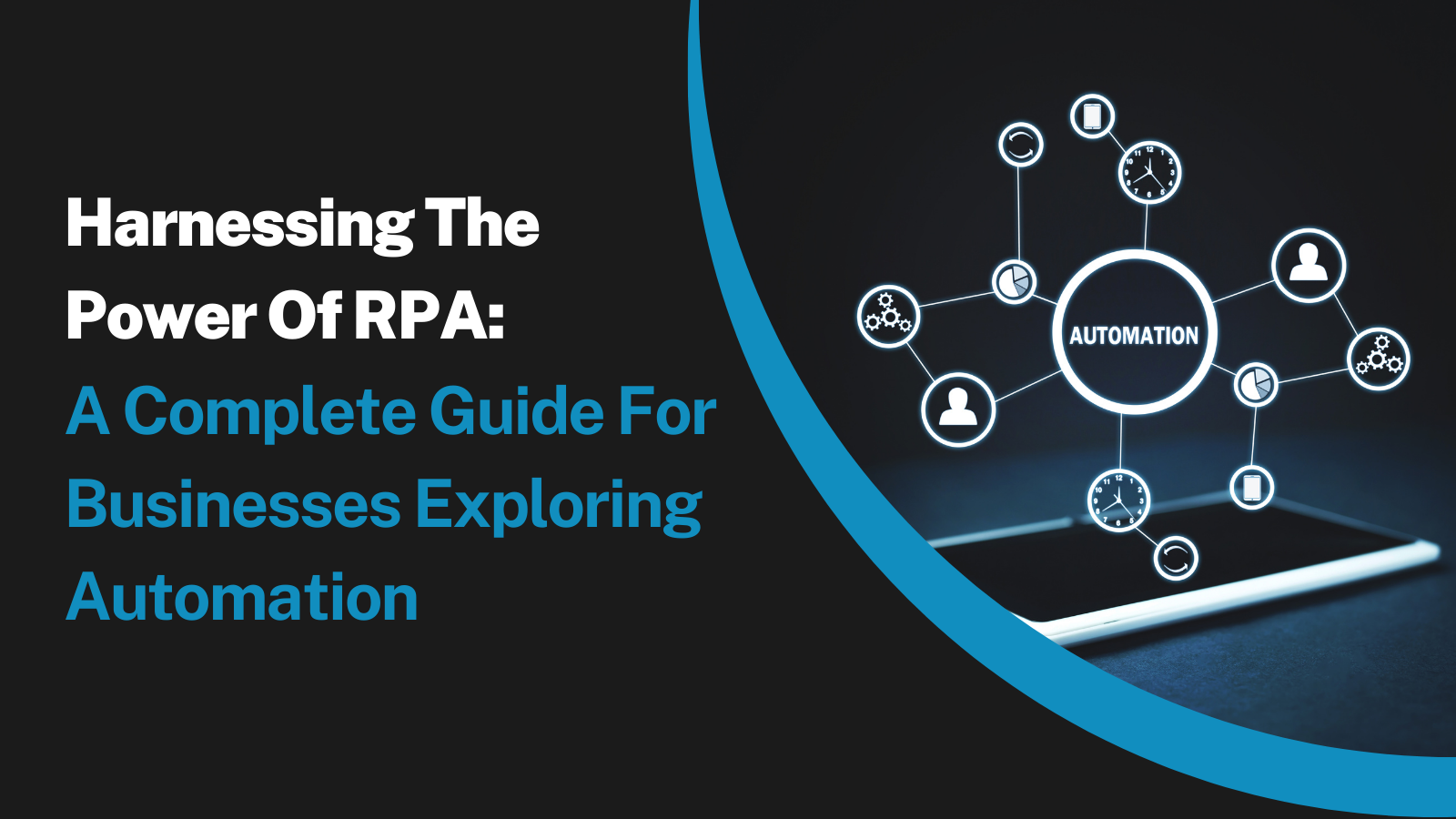
Welcome to the world of harnessing RPA for efficient and error-free business operations! Imagine a future where repetitive and mundane tasks are taken care of by robots, freeing up human resources to focus on more strategic and creative endeavors. Robotic Process Automation (RPA) is revolutionizing the way businesses operate, streamlining processes, reducing errors, and boosting productivity. In this article, we will explore the power of RPA and how it can transform your business operations.
RPA utilizes software robots or “bots” to automate routine tasks, mimicking human actions and interactions with various computer systems. These bots can perform a wide range of activities, such as data entry, report generation, data validation, and even complex decision-making processes. By harnessing the power of RPA, businesses can achieve higher efficiency and accuracy in their operations, eliminating the risk of human error and reducing the time and effort required for repetitive tasks.
With RPA, you can bid farewell to manual data entry and the potential for human error. These bots work tirelessly, 24/7, ensuring that your business processes are executed flawlessly. By automating these tasks, you can enhance your operational efficiency, improve customer satisfaction, and drive growth. So, let’s dive into the world of RPA and discover how it can revolutionize your business operations!
Harnessing RPA (Robotic Process Automation) is a game-changer for businesses seeking efficient and error-free operations. By automating repetitive and rule-based tasks, RPA allows organizations to streamline processes, increase productivity, and reduce human errors. With RPA, companies can leverage software robots to perform these tasks with precision and speed, freeing up human employees to focus on more value-added activities. The result is improved efficiency, cost savings, and enhanced customer satisfaction. Embracing RPA can revolutionize business operations, enabling companies to stay competitive in today’s fast-paced digital landscape.

Harnessing RPA for Efficient and Error-free Business Operations
Harnessing Robotic Process Automation (RPA) has become a game-changer for businesses seeking to streamline their operations and improve overall efficiency. RPA involves the use of software robots or bots to automate repetitive and rule-based tasks, freeing up employees to focus on more strategic and value-added activities. By automating mundane tasks, businesses can reduce errors, minimize operational costs, and increase productivity. In this article, we will explore the benefits and implementation strategies of harnessing RPA for efficient and error-free business operations.
The Benefits of RPA
RPA offers a wide range of benefits to businesses across various industries. Firstly, it significantly reduces errors and improves accuracy by eliminating human intervention in repetitive tasks. With RPA, businesses can ensure that tasks are performed consistently and without the risk of human error. This is particularly beneficial in industries that require high levels of accuracy, such as finance, healthcare, and legal services.
Secondly, RPA improves efficiency by automating time-consuming tasks. Software robots can work 24/7 without the need for breaks, resulting in faster task completion and improved turnaround times. This allows businesses to handle large volumes of work more effectively, increasing overall productivity and customer satisfaction.
Additionally, RPA helps businesses achieve cost savings by reducing labor costs. By automating repetitive tasks, businesses can reallocate employees to more valuable and strategic activities, maximizing their skills and expertise. This not only improves employee satisfaction but also reduces the need for additional hiring, resulting in significant cost savings.
Moreover, RPA provides scalability and flexibility to businesses. As business requirements change, RPA can easily adapt and scale to meet evolving needs. Whether it’s handling increased transaction volumes or incorporating new processes, RPA can be easily configured and deployed, ensuring businesses remain agile and responsive to market demands.

Implementation Strategies for RPA
Implementing RPA requires careful planning and strategic execution. Here are some key strategies to consider:
1. Identify and prioritize processes: Begin by identifying processes that are repetitive, rule-based, and time-consuming. Prioritize processes that have a high impact on efficiency and accuracy. This helps in determining the areas where RPA can have the most significant benefits.
2. Evaluate RPA tools: There are various RPA tools available in the market. Evaluate different options based on factors like ease of use, scalability, and compatibility with existing systems. Choose a tool that aligns with your business requirements and provides the necessary features for seamless integration.
3. Engage stakeholders: Involving key stakeholders from different departments is crucial for successful RPA implementation. Seek input from process owners, IT teams, and employees who will be directly affected by the automation. Their insights and expertise can help identify potential challenges and ensure a smooth transition.
4. Conduct a pilot project: Start with a small-scale pilot project to test the effectiveness of RPA in real-world scenarios. This allows for fine-tuning and identifying any potential issues before implementing RPA across the organization. Analyze the results and gather feedback from stakeholders to make necessary adjustments.
5. Provide training and support: Proper training and support are essential to ensure employees are comfortable with the new technology. Offer comprehensive training programs to familiarize employees with the RPA tools and processes. Establish a support system to address any concerns or issues that may arise during the implementation phase.
6. Monitor and optimize performance: Regularly monitor the performance of RPA bots and processes to identify areas for improvement. Analyze data and metrics to measure the impact of RPA on efficiency, accuracy, and cost savings. Continuously optimize and refine RPA processes to maximize benefits over time.
By following these implementation strategies, businesses can effectively harness RPA to achieve efficient and error-free operations. RPA has the potential to revolutionize the way businesses operate, bringing automation and optimization to various processes. With its numerous benefits and strategic implementation, RPA is undoubtedly a valuable tool for businesses striving for operational excellence. So, embrace the power of RPA and unlock new levels of efficiency and productivity in your organization.

Key Takeaways
- RPA stands for Robotic Process Automation.
- RPA helps businesses automate repetitive tasks.
- Using RPA improves operational efficiency.
- RPA reduces the risk of errors in business operations.
- Implementing RPA saves time and resources.
Frequently Asked Questions
What is Robotic Process Automation (RPA) and how can it improve business operations?
Robotic Process Automation (RPA) is a technology that uses software robots to automate repetitive and rule-based tasks in business processes. By mimicking human actions, RPA can perform tasks such as data entry, data manipulation, and report generation with speed and accuracy.
Implementing RPA in business operations can lead to improved efficiency and error reduction. RPA robots can work 24/7 without breaks, ensuring continuous productivity. They can also complete tasks faster than humans, leading to reduced processing times and increased throughput. With the ability to eliminate manual errors, RPA helps maintain data accuracy and quality, ultimately improving overall business operations.
What are the key benefits of harnessing RPA for business operations?
Harnessing RPA for business operations offers several key benefits. Firstly, it enables significant time savings by automating repetitive tasks, allowing employees to focus on more strategic and value-added activities. This leads to increased productivity and efficiency within the organization.
RPA also improves accuracy and reduces errors by eliminating manual data entry and manipulation. With automated data processing, businesses can minimize the risk of human error and ensure greater data integrity. This not only enhances the quality of business operations but also improves customer satisfaction.
How can RPA enhance operational efficiency in business processes?
RPA can enhance operational efficiency in business processes by automating time-consuming and repetitive tasks. By delegating these tasks to software robots, employees can allocate their time and effort to more critical and complex activities, improving overall productivity.
Additionally, RPA can streamline workflows by integrating with existing systems and applications. This allows for seamless data exchange and process synchronization, reducing bottlenecks and delays in business operations. With increased efficiency, organizations can achieve faster turnaround times, reduced costs, and improved customer service.
Is RPA suitable for all types of business operations?
RPA is suitable for a wide range of business operations across various industries. It can be applied to tasks that are rule-based, repetitive, and require minimal human judgment. Industries such as finance, healthcare, manufacturing, and customer service can benefit from RPA implementation.
However, it is important to assess the suitability of RPA for specific business operations before implementation. Complex tasks that involve high levels of decision-making or require creativity may not be suitable for automation through RPA. It is crucial to evaluate the feasibility and potential benefits of RPA in each specific operational context.
What are the potential challenges in harnessing RPA for business operations?
While RPA offers numerous benefits, there can be challenges in its implementation and utilization for business operations. One challenge is the need for proper planning and analysis before implementing RPA. It is important to identify the right processes for automation and ensure compatibility with existing systems and infrastructure.
Another challenge is ensuring proper governance and control over RPA robots. Organizations need to establish robust security measures to protect sensitive data and ensure compliance with regulations. Additionally, continuous monitoring and maintenance are required to address any issues or updates in the RPA environment. Overall, careful consideration and proactive management can help overcome these challenges and harness RPA effectively.

Final Summary
As we wrap up our exploration of harnessing RPA for efficient and error-free business operations, it’s clear that this cutting-edge technology has the potential to revolutionize the way organizations operate. By automating repetitive tasks and eliminating human errors, RPA offers a myriad of benefits that can drive productivity, accuracy, and cost savings.
One of the key takeaways from our discussion is that RPA enables businesses to streamline their operations by automating mundane and time-consuming tasks. With the ability to handle repetitive processes with precision and speed, RPA frees up valuable human resources, allowing employees to focus on more strategic and value-added activities. This not only enhances productivity but also empowers employees to utilize their skills and expertise to drive innovation and growth.
Furthermore, RPA plays a pivotal role in minimizing errors and increasing accuracy in business operations. By eliminating the risk of manual data entry mistakes and ensuring consistent adherence to predefined rules, RPA helps organizations maintain data integrity and make informed decisions. This not only enhances the overall quality of work but also reduces costly errors that can have a significant impact on the bottom line.
In conclusion, by harnessing the power of RPA, businesses can unlock a world of possibilities in terms of operational efficiency and error-free processes. As organizations continue to embrace digital transformation, incorporating RPA into their operations becomes a strategic imperative. By automating repetitive tasks and ensuring accuracy, RPA empowers businesses to thrive in today’s fast-paced and competitive landscape. So, seize the opportunity, embrace RPA, and embark on a journey towards enhanced productivity, streamlined operations, and error-free business processes.


